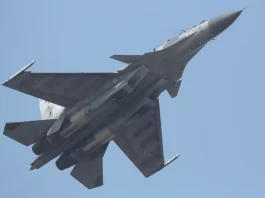It appeared that the era of free-falling bombs had ended in the 1960s. The development of anti-aircraft missiles would never permit bombers to fly over enemy territory and strike with high-explosive aerial bombs. Nevertheless, the nature of the conflicts demonstrated that it was premature to dismiss the free-fall bombs. Initially, missiles are considerably more expensive. Secondly, not all adversaries have anti-aircraft missile systems. If they do, these systems can be destroyed, thereby allowing for the deployment of ariel bombs.
Nevertheless, the Russian conflict with a high-tech adversary, in this case, Ukraine, demonstrated that it was difficult to neutralize air defenses. The devastated systems are promptly replaced by new ones. So, what can be done?
The solution was provided by ariel bombs which Russia abbreviates as FABs with UMPC (Unified Planning and Correction Module). This device is a small unit with wings attached to the FAB, transforming it into a nearly missile-like weapon, albeit with a restricted range. Just how restricted? It is contingent upon one’s viewpoint. Today’s Russian UMPCs can execute attacks from up to 70 kilometers from the targets.
What are the disadvantages of UMPCs? The primary, and potentially only drawback is that the flight range is significantly influenced by the weather. For instance, the strike range is substantially diminished by a headwind. The launch conditions are an additional constraint. To accomplish the desired outcomes, bombs equipped with UMPC must be dropped from a specific altitude and at a specific speed. A reduced range is associated with a lower altitude. Enemy anti-aircraft systems find it simpler to target aircraft at higher altitudes. Nevertheless, they can remain in the “death zone” for anti-aircraft missiles by remaining below the radar near the ground. However, FABs are incapable of being deployed effectively from such low altitudes, at least not over very long distances.
In such circumstances, missiles are typically employed to engage targets; however, the cost issue resurfaces. Typically, these missiles are employed exclusively to strike the most critical targets.
Nevertheless, it appears that the cost issue, at least about the Kh-38 missiles, has been largely resolved. Alternatively, it is possible that the issue was not price, but rather quantity. The Russian Aerospace Forces are currently receiving an adequate quantity of new missiles to employ them against both critical targets and typical field fortifications, as was recently demonstrated in the Kharkiv region. There were reports that a Kh-38 missile, which was guided by a laser beam, struck the center of a fortified Ukrainian army position with precision. So, what is this weapon?
The Kh-38 missile is a relatively recent development that was initially introduced at the MAKS-2007 air show. Its range is 40 kilometers, which is shorter than that of bombs equipped with UMPC. However, as previously mentioned, it can be launched from nearly any altitude.
The warhead of the missile is 250 kg, which is comparable to the FAB-500 warhead. It may be armed with cluster, penetrating, or high-explosive fragmentation warheads.
This missile is capable of being transported by nearly all combat helicopters and aircraft of the Russian Aerospace Forces; however, the helicopter version is outfitted with a unique booster.
The missile can be equipped with a variety of guidance systems, depending on the circumstances of combat; however, the fundamental version is laser-guided.
The “Grom-1” and “Grom-2” “missile bombs” were developed by the Tactical Missiles Corporation in 2015, and they are based on the Kh-38. The export versions are classified as Grom-E1 and Grom-E2. The Grom-1 is a guided missile that contains a potent warhead that weighs 520 kg. The Grom-2 is a gliding weapon that replaces the engine with an additional 165 kg warhead, resulting in a total weight of 598 kg. It is presently unknown whether these modifications are being used in Ukraine.






